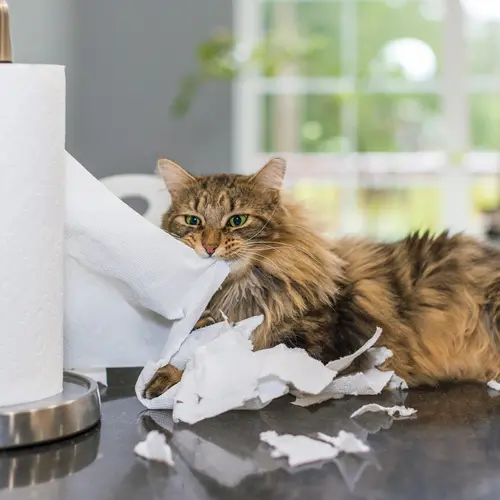Feline hyperesthesia is a condition in which your cat has increased sensitivity in parts of their skin. Your cat may react when you try to pet this area.
The word hyperesthesia means increased sensitivity. When you pet your cat, they will react as if in pain. Their skin may even twitch when touched.
Hyperesthesia in cats is also known by other names, such as:
- Twitchy cat disease
- Rolling skin syndrome
- Apparent neuritis
- Atypical neurodermatitis
Hyperesthesia syndrome tends to be found in younger cats between ages 1 and 5. Any breed of cat can get hyperesthesia, but it’s more common in Oriental breeds like:
- Abyssinian
- Persian
- Burmese
- Siamese
What Are the Causes of Feline Hyperesthesia?
The exact cause of hyperesthesia syndrome in cats is unknown. It’s been linked to various conditions such as:
- Tail trauma
- Brain disorders such as epilepsy
- Spinal disease
- Muscle problems
Some experts say that it may be a type of obsessive-compulsive disorder, while others say that it may be related to seizures.
What Are the Symptoms of Feline Hyperesthesia?
When you pet your cat, they may react in different ways:
- Scratching the area
- Compulsively grooming
- Licking or biting their paws
- Becoming aggressive and trying to bite you
- Drooling
- Chasing their tail
- Urinating
- Running around the house
- Skin twitches
- Pupils dilate
- Excessive vocalization, such as yowling and screaming
In severe cases, cats with this syndrome may damage or mutilate their own tail.
These behaviors can appear for no obvious reason, and your cat may look confused afterwards. The episodes may take place every few days or almost every day. They may last a few seconds or a few minutes.
How Is Feline Hyperesthesia Diagnosed?
Your vet may first try to rule out other possible causes for your cat’s behavior. They may look for other sources of pain in the area. This includes arthritis of the spine and skin problems like allergies and parasites.
Since the tail is often the site of self-mutilation, your vet may also check for injuries such as old tail fractures that may be the cause of nerve or muscle spasms.
Other possible tests include:
- Fungal culture to check for ringworm
- Muscle or skin biopsies
- Blood work
- Analysis of urine and feces
- Skin scrapings to look for parasites or mites
- Allergy tests
- Corticosteroid response test to see if controlling the itch improves your cat’s condition
- X-rays of the spine
- Computed tomography (CT) or magnetic resonance imaging (MRI) scans
What Is the Treatment for Feline Hyperesthesia?
Most cats' hyperesthesia can be managed with treatment, though they may not be completely cured. Treatment should help to stop the self-mutilation, reduce discomfort, and improve quality of life. The type of treatment depends on the symptoms your cat has.
Manage itching. Itching often leads to grooming, which may turn into overgrooming or even self-mutilation. To control itching, make sure there are no fleas in your cat’s surroundings.
Medications like corticosteroids can be used for skin inflammation. To decrease skin sensitivity, your vet may recommend adding omega-3 fatty acid supplements to your cat’s diet.
Seizures. If your cat has seizures, your vet may prescribe medication such as phenobarbital or gabapentin. Gabapentin not only helps with seizures but also is effective for managing pain caused by nerves that are oversensitive.
Compulsive grooming. Toys or other objects of stimulation may help distract your cat during a compulsive grooming episode. Your vet may also prescribe medications that modify behavior, such as clomipramine and fluoxetine.
Manage anxiety. Experts say that stress and anxiety may increase your cat’s hyperesthesia reaction. Besides behavior-modifying medications, you may also want to establish routines to help minimize stress in your cat’s life.
Some ways you can help reduce your cat's anxiety include:
- Separating them from other cats if they don’t get along well
- Feed other cats separately so there's less competition for food
- Close your curtains if the outdoors stress your cat
Cats with feline hyperesthesia can’t control their actions, so don’t punish them for their behavior.
Boredom can also stress your cat. You can try to create a more stimulating environment in these ways:
- Play with them
- Change their toys on a regular basis
- Provide structures to climb on and scratching posts
- Feed at the same time at least twice a day
- Put on some music when you’re away from your house
- If the outdoors doesn’t stress your cat, get a perch so they can watch what’s going on outside
Some cats may need a combination of different treatments to reduce their hyperesthesia.

